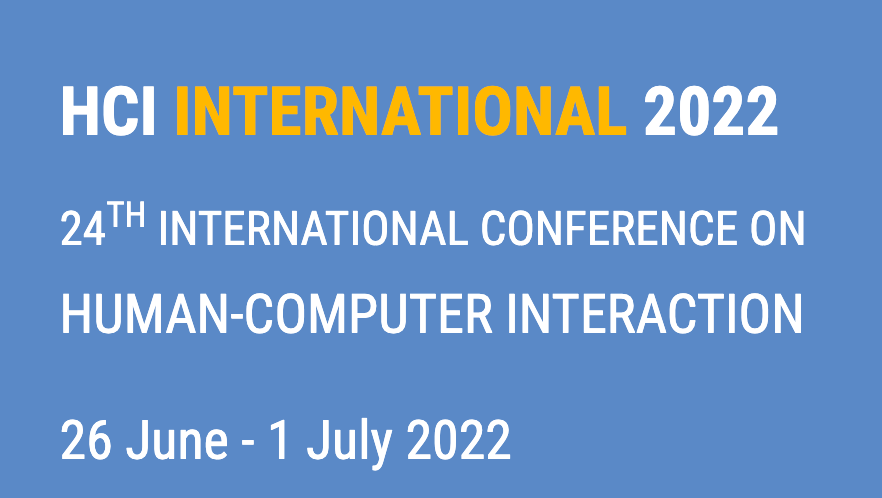
Call for Contributions
Multi-modal innovations in media accessibility technologies: special session proposal for HCI 2022
Session organizers: Krishna Chandramouli, Giacomo Inches, Nasrine Olson, Monica Florea
Deadline: December 17th, 2021
Aim and scope
Digital content accessibility refers to the inclusive practice of making digital contents usable and comprehensible by all citizens of all abilities. Within the current adoption of digital transformation strategies, the notion of accessibility has been widely addressed within the context of information being shared through Internet services. The relevant standards published from W3C on Web Accessibility Initiative (WAI) individuals’ formulated recommendations on creating accessible for all content published online. The recommendations on adopting universal design, that includes the triple synergy between Usability, Accessibility and Inclusion has been well addressed in the literature [1]. Nevertheless, the lack of support for integrating such accessibility standards within individual organisations has also been well documented [2], resulting in the information published from media organisations inaccessible. Additionally, the lack of multimodal, user engagement tools has resulted in unimodal representation (in text) of digital media. The representation of conservative and generic content, that cannot address different individual's needs and preferences, has been identified as a key limitation in engaging wider public. Despite the popularity of the audio-visual content, commonly encountered within the media organisations, limitations and barriers are still preventing Audio Visual Media Accessibility, being related to usability, interoperability, and standards issues, as well as lack of business-case for take-up by mainstream actors, legal barriers (for example for the transnational reuse of accessible content), difficulties in the reuse of accessible content over time and across different platforms [3]. These challenges need to be overcome for delivering wider access to the digital content to many communities.
For people with a disability such as those with hearing or visual impairments or mobility barriers, effective engagement with digital media content and interacting with social media applications provide extra barriers. Following the reports on aging population across Europe, there is a critical need to develop digital technologies considering inclusion by design principles. Addressing the challenge, in 2015, Netflix launched the Accessible Netflix Project (ANP), with the vision of offering audio description of its original content [Daredevil, House of Cards, Orange is the New Black] or its audience with visual impairments. While a television show featuring a character with an impairment such as Daredevil’s Matt Murdock’s vision impairment would be of interest to theorists in critical disability studies, the question of whether the program itself is accessible to viewers with the same impairment has not garnered much attention. Despite an increase in the design and development of assistive technologies which has been released in the market for over a decade, the lack of content production tools and services focused on cultural heritage has negatively impacted the market uptake of such assistive technologies. As an instance, the uptake of Haptic solutions to offer a sensory experience of touch and otherwise, has not gained momentum among people with disabilities, has not gained popularity among people with disabilities and otherwise, because they offer limited and very basic functionality to the users, e.g., white canes [4]. Additionally, the inclusion by design principles should consider literacy levels of citizens, refugees, heritage of immigrants to offer a holistic experience to all public for experience cultural heritage. Addressing these shortcomings, it is vital to consider the inclusive design principles, which is aimed to remove the barriers that create undue effort and separation. Information created, shared, and distributed should facilitate everyone to participate equally, confidently, and independently.
[1] Stephanidis, C. (Ed.). (2009). The universal access handbook. CRC Press.
[2] https://unesdoc.unesco.org/ark:/48223/pf0000232026
[3] Longo, D. & Boeri, Andrea & Turillazzi, Beatrice & ORLANDI, SERENA. (2020). CULTURAL HERITAGE AND INTEROPERABLE OPEN PLATFORMS: STRATEGIES FOR KNOWLEDGE, ACCESSIBILITY, ENHANCEMENT AND NETWORKING. 371-382. 10.2495/SDP200301.
Topics of specific interest
Addressing the growing needs and demands of digital accessibility for all citizens, the special issue invites original contributions from authors on the following list of topics (but not limited to):
- Accessibility and inclusion
- Multimodal signal processing for digital content transformation
- Content adaptations for digital accessibility
- Advanced multi-dimensional accessible content visualisation
- Deep-learning algorithms for accessible content generation
- International standards for the media accessibility
- Design principles and methodologies for accessibility
- Haptic technologies for enhanced accessibility
- Haptic Communication Systems
- Haptic language systems
Important dates
- Paper submission: 17th December 2021
- Peer-review feedback: 21st January 2022
- Author registration: 11th February 2022
- Conference: 26th June to 1st July 2022 (Online)
Session organizers
- Krishna Chandramouli, Venaka Media Limited, United Kingdom,
- Giacomo Inches, Martel-Innovate, Switzerland,
- Nasrine Olson, University of Borås, Sweden,
- Monica Florea, SIMA VI, Romania.
